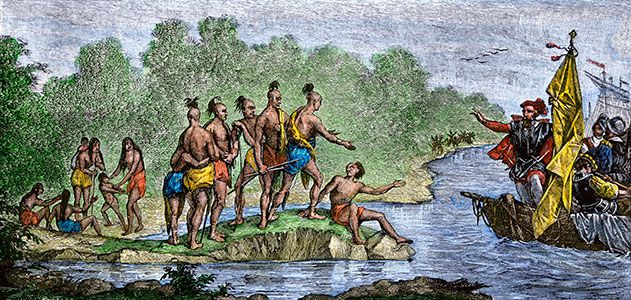Africa and Middle EastAllAllAllEuropeOngoingOngoingOngoingThe Americas
What Was the Columbian Exchange?
Named after Columbus of Spain, the Columbian exchange was the trans-oceanic transmission of plants, animals and microorganisms across the Atlantic Ocean. Occurring in the late fifteenth and sixteenth centuries, the consequences to ecosystems affected were far reaching and consequential.

The Columbian Exchange was coined by American historian Alfred Crosby in 1972. The start of the Columbian exchange began when Christopher Columbus began to colonize the Americas
Crops Brought by the Columbian Exchange
Many contemporary crop staples native to the Americas resulted from the Columbia exchange. These include tomatoes, maize, potatoes and tobacco. Popularity of some of these crops, notably the potato, contributed to approximately 25% of population growth in Afro-Eurasia between 1700-1900.
Conversely, crops such as citruses, oats and grapes were brought to the Americas from the old world. As demand grew for the trade of the crops, methodologies on how to cultivate them did as well. Originating in the Mediterranean region, the crops acclimated to the new world and thrived in production by the end of the nineteenth century.
Disease Fostered by the Columbian Exchange
Many crippling epidemics occurred as a result of the Columbian Exchange. Notably, yellow fever is thought to have been transmitted to the Americas via the Atlantic Slave Trade. Because yellow fever occurred endemically in Africa, many of the slaves had developed a natural immunity to the disease; it affected those of European descent at a much greater voracity.
Although the exact origin of syphilis is unclear, one hypothesis suggests that syphilis was transmitted to Europe from the Americas from Columbus’ earliest voyages in the 1490s. The first documented descriptions of the disease in the Old World in 1493; the first major syphilis outbreak occurred in 1495 in Naples, Italy during Charles VIII’s invasion.
The Human Cost
The Trans-Atlantic slave trade was a product of the Columbian Exchange. This was the transfer of slaves of Western African origin across the Atlantic, occurring between the sixteenth and nineteenth centuries. During this period, approximately 10 million slaves arrived in the Americas, called wither the triangle trade route or middle passage.
The conditions and treatment of slaves became one of the most controversial topics in recent history of the “New World.” The slave trade was abolished in 1865, but still remains a key subject of study and discussion in politics, media and pop culture circles. Descendants of these slaves became the contemporary African-American populations in the United States.


